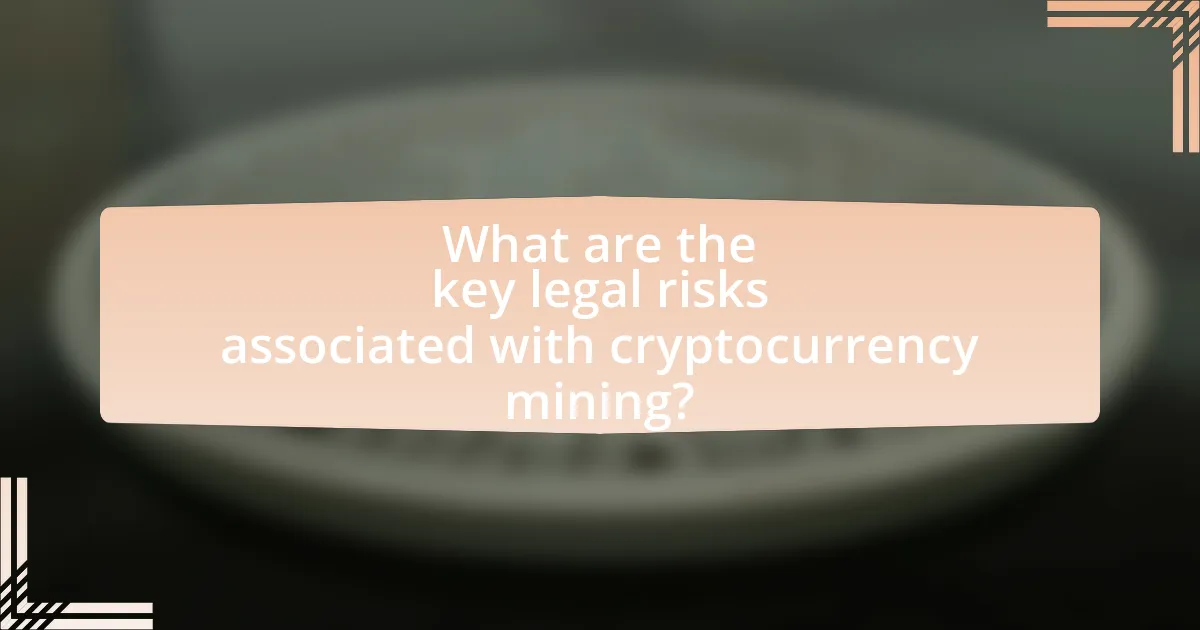The article focuses on strategies for managing legal risks in cryptocurrency mining, highlighting key legal challenges such as regulatory compliance, environmental regulations, and intellectual property issues. It discusses the impact of varying regulatory frameworks across jurisdictions on mining operations, emphasizing the importance of understanding local laws to avoid penalties. Additionally, the article outlines specific regulations miners should be aware of, potential liabilities they may face, and best practices for ensuring compliance and mitigating risks. It also addresses the role of legal counsel and risk management practices in navigating the complex legal landscape of cryptocurrency mining.

What are the key legal risks associated with cryptocurrency mining?
The key legal risks associated with cryptocurrency mining include regulatory compliance, environmental regulations, and intellectual property issues. Regulatory compliance risks arise from varying laws across jurisdictions, which can lead to penalties if mining operations do not adhere to local regulations. Environmental regulations pose risks due to the significant energy consumption of mining activities, which may violate laws aimed at reducing carbon emissions. Intellectual property issues can occur if miners inadvertently infringe on patents or copyrights related to mining technology or software. These risks highlight the importance of understanding and navigating the complex legal landscape surrounding cryptocurrency mining.
How do regulatory frameworks impact cryptocurrency mining operations?
Regulatory frameworks significantly impact cryptocurrency mining operations by establishing legal guidelines that dictate where, how, and under what conditions mining can occur. These regulations can influence operational costs, as jurisdictions with stringent environmental laws may impose higher compliance costs on miners, while regions with favorable regulations may attract more mining activities. For instance, in China, the government has imposed bans on cryptocurrency mining due to environmental concerns, leading to a mass exodus of miners to countries with more lenient regulations, such as Kazakhstan and the United States. This shift illustrates how regulatory environments can directly affect the location and viability of mining operations, shaping the global landscape of cryptocurrency mining.
What specific regulations should miners be aware of?
Miners should be aware of regulations related to environmental compliance, financial reporting, and taxation. Environmental regulations often require miners to adhere to local laws regarding energy consumption and waste management, as seen in jurisdictions like California, where strict emissions standards are enforced. Financial reporting regulations mandate transparency in transactions and may require compliance with anti-money laundering (AML) laws, such as the Financial Crimes Enforcement Network (FinCEN) guidelines in the United States. Additionally, taxation regulations vary by region, with some areas imposing specific taxes on cryptocurrency transactions and mining profits, necessitating accurate reporting to avoid penalties.
How do different jurisdictions approach cryptocurrency mining regulations?
Different jurisdictions adopt varied approaches to cryptocurrency mining regulations, reflecting their economic priorities and environmental concerns. For instance, China has implemented strict bans on cryptocurrency mining due to its high energy consumption and environmental impact, leading to a significant decline in mining activities within its borders. Conversely, countries like Kazakhstan have welcomed miners, offering low electricity costs and favorable regulations, which has resulted in a surge of mining operations there. In the United States, regulations vary by state; Texas promotes cryptocurrency mining through deregulation and incentives, while New York has imposed a moratorium on new mining operations to assess environmental impacts. These regulatory differences illustrate how jurisdictions balance economic benefits against environmental sustainability in their cryptocurrency mining policies.
What are the potential liabilities for cryptocurrency miners?
Cryptocurrency miners face potential liabilities including regulatory compliance issues, environmental concerns, and cybersecurity risks. Regulatory compliance issues arise as miners must adhere to varying laws and regulations across jurisdictions, which can lead to fines or legal action if not followed. Environmental concerns stem from the significant energy consumption associated with mining, potentially resulting in penalties or restrictions from local governments aiming to reduce carbon footprints. Cybersecurity risks involve the potential for hacking or theft of mined cryptocurrencies, which can lead to financial losses and legal repercussions if proper security measures are not implemented. These liabilities highlight the importance of understanding and managing the legal landscape surrounding cryptocurrency mining.
How can miners be held accountable for environmental impacts?
Miners can be held accountable for environmental impacts through regulatory frameworks, legal liabilities, and community engagement. Regulatory frameworks, such as the Environmental Protection Agency’s guidelines in the United States, require miners to adhere to specific environmental standards, including emissions limits and waste management protocols. Legal liabilities arise when miners violate these regulations, leading to fines or lawsuits, as seen in cases where mining operations have been penalized for non-compliance with environmental laws. Additionally, community engagement initiatives can hold miners accountable by fostering transparency and allowing local stakeholders to voice concerns, thereby ensuring that mining practices align with community environmental standards.
What legal issues arise from intellectual property in mining software?
Legal issues arising from intellectual property in mining software include copyright infringement, patent disputes, and trade secret misappropriation. Copyright infringement occurs when mining software is copied or distributed without authorization, violating the rights of the original creator. Patent disputes can arise if a mining software utilizes patented algorithms or processes without permission, leading to potential litigation. Additionally, trade secrets may be at risk if proprietary algorithms or methods are disclosed or used without consent, which can result in legal action for misappropriation. These issues highlight the importance of protecting intellectual property rights in the rapidly evolving field of cryptocurrency mining.

What strategies can be employed to mitigate legal risks in cryptocurrency mining?
To mitigate legal risks in cryptocurrency mining, operators should implement comprehensive compliance strategies that include understanding and adhering to local regulations, obtaining necessary licenses, and conducting regular legal audits. Compliance with regulations such as anti-money laundering (AML) and know your customer (KYC) laws is crucial, as failure to comply can result in significant fines and legal action. Additionally, securing appropriate permits for land use and energy consumption is essential, as many jurisdictions have specific requirements for mining operations. Regular legal audits help identify potential risks and ensure ongoing compliance with evolving laws. These strategies collectively reduce the likelihood of legal challenges and enhance the legitimacy of mining operations.
How can miners ensure compliance with local laws and regulations?
Miners can ensure compliance with local laws and regulations by conducting thorough research on applicable legal frameworks and obtaining necessary permits. This involves understanding zoning laws, environmental regulations, and tax obligations specific to their jurisdiction. For instance, in the United States, miners must adhere to state-specific regulations regarding energy consumption and emissions, as well as federal tax laws that apply to cryptocurrency transactions. Additionally, engaging with legal experts and local authorities can provide clarity on compliance requirements, helping miners avoid potential legal pitfalls.
What steps should be taken to stay updated on regulatory changes?
To stay updated on regulatory changes, individuals and organizations should regularly monitor official government websites and regulatory bodies relevant to cryptocurrency. This includes subscribing to newsletters from agencies like the Financial Crimes Enforcement Network (FinCEN) and the Securities and Exchange Commission (SEC), which provide updates on new regulations and guidance. Additionally, attending industry conferences and webinars can offer insights into upcoming changes and trends. Engaging with legal experts and industry associations can also facilitate timely information sharing about regulatory developments. These steps ensure that stakeholders remain informed and compliant with evolving legal frameworks in cryptocurrency mining.
How can legal counsel assist in navigating compliance issues?
Legal counsel can assist in navigating compliance issues by providing expert guidance on regulatory requirements specific to cryptocurrency mining. They help organizations understand and interpret complex laws, such as anti-money laundering (AML) and know your customer (KYC) regulations, which are critical in the cryptocurrency sector. Legal professionals can also conduct compliance audits to identify potential risks and ensure adherence to applicable laws, thereby minimizing the likelihood of legal penalties. Furthermore, they can assist in drafting policies and procedures that align with regulatory standards, ensuring that companies operate within the legal framework. This proactive approach is essential, as non-compliance can lead to significant financial and reputational damage, evidenced by the increasing number of enforcement actions taken against non-compliant entities in the cryptocurrency industry.
What risk management practices can be implemented in mining operations?
Risk management practices that can be implemented in mining operations include conducting thorough risk assessments, establishing safety protocols, and ensuring compliance with regulatory requirements. Conducting risk assessments helps identify potential hazards and vulnerabilities specific to mining activities, allowing for the development of targeted mitigation strategies. Establishing safety protocols, such as regular training for workers and emergency response plans, enhances operational safety and reduces the likelihood of accidents. Ensuring compliance with regulatory requirements, including environmental laws and labor regulations, minimizes legal risks and potential penalties. These practices are essential for maintaining operational integrity and protecting both workers and the environment in mining operations.
How can miners conduct effective risk assessments?
Miners can conduct effective risk assessments by systematically identifying, analyzing, and prioritizing potential legal risks associated with cryptocurrency mining operations. This process involves reviewing relevant regulations, assessing compliance with local laws, and evaluating the operational environment for factors such as energy consumption, environmental impact, and data security.
For instance, a study by the Cambridge Centre for Alternative Finance highlights that understanding jurisdictional regulations can significantly mitigate legal risks, as non-compliance can lead to substantial fines or operational shutdowns. Additionally, miners should implement regular audits and engage legal experts to ensure ongoing compliance and adapt to evolving legal landscapes.
What role does insurance play in managing legal risks?
Insurance plays a critical role in managing legal risks by providing financial protection against potential liabilities arising from legal claims. In the context of cryptocurrency mining, insurance can cover various legal exposures, such as regulatory compliance issues, intellectual property disputes, and contractual liabilities. For instance, liability insurance can help mitigate the financial impact of lawsuits related to data breaches or environmental regulations, which are particularly relevant in the cryptocurrency sector. Additionally, having insurance can enhance a mining operation’s credibility and stability, making it more attractive to investors and partners, as it demonstrates a proactive approach to risk management.

What are the best practices for managing legal risks in cryptocurrency mining?
The best practices for managing legal risks in cryptocurrency mining include ensuring compliance with local regulations, implementing robust contracts, and maintaining transparent financial records. Compliance with local regulations is crucial, as laws governing cryptocurrency vary significantly by jurisdiction; for example, in the United States, miners must adhere to federal and state laws regarding taxation and energy consumption. Implementing robust contracts with suppliers and partners helps mitigate risks related to service delivery and liability. Additionally, maintaining transparent financial records aids in demonstrating compliance during audits and can protect against potential legal disputes. These practices collectively reduce the likelihood of legal challenges and enhance operational integrity in cryptocurrency mining.
How can miners develop a robust legal strategy?
Miners can develop a robust legal strategy by conducting thorough legal research and engaging with legal experts specializing in cryptocurrency regulations. This approach ensures that miners understand the evolving legal landscape, including compliance with local, national, and international laws. For instance, in the United States, miners must navigate regulations from agencies like the SEC and IRS, which have specific guidelines on taxation and securities. Additionally, miners should implement risk management practices, such as maintaining accurate records and ensuring transparency in operations, to mitigate potential legal disputes. By staying informed and proactive, miners can effectively address legal challenges and protect their interests in the cryptocurrency mining sector.
What key elements should be included in a legal risk management plan?
A legal risk management plan should include the following key elements: risk identification, risk assessment, risk mitigation strategies, compliance monitoring, and documentation procedures. Risk identification involves recognizing potential legal issues related to cryptocurrency mining, such as regulatory compliance and intellectual property rights. Risk assessment evaluates the likelihood and impact of these identified risks, allowing for prioritization. Risk mitigation strategies outline specific actions to reduce or eliminate risks, such as implementing legal audits and engaging legal counsel. Compliance monitoring ensures adherence to relevant laws and regulations, which is crucial in the rapidly evolving cryptocurrency landscape. Finally, documentation procedures maintain records of risk management activities, which are essential for accountability and future reference. These elements collectively create a comprehensive framework for managing legal risks effectively in cryptocurrency mining.
How can miners engage with legal experts effectively?
Miners can engage with legal experts effectively by establishing clear communication channels and defining specific legal needs. This involves outlining the regulatory landscape relevant to cryptocurrency mining, such as compliance with local laws and environmental regulations. By providing legal experts with detailed information about their operations, miners can receive tailored advice that addresses their unique challenges. Furthermore, regular consultations and updates on legal developments can enhance the relationship, ensuring that miners remain informed and compliant. Engaging in workshops or seminars led by legal professionals can also facilitate a deeper understanding of legal risks and best practices in the industry.
What common pitfalls should miners avoid to reduce legal exposure?
Miners should avoid operating without proper licenses and permits to reduce legal exposure. Engaging in cryptocurrency mining without adhering to local regulations can lead to significant legal penalties, including fines and shutdowns. For instance, in various jurisdictions, mining operations are required to obtain specific licenses related to energy consumption and environmental impact. Additionally, miners should ensure compliance with tax obligations, as failure to report income from mining activities can result in audits and legal action. By proactively addressing these regulatory requirements, miners can mitigate the risk of legal challenges and maintain operational continuity.
What are the most frequent legal mistakes made by cryptocurrency miners?
Cryptocurrency miners frequently make legal mistakes such as failing to comply with local regulations, neglecting tax obligations, and not securing necessary licenses. Non-compliance with local regulations can lead to fines or shutdowns, as many jurisdictions have specific laws governing cryptocurrency activities. Additionally, miners often overlook tax implications, which can result in significant penalties; for instance, the IRS requires reporting of cryptocurrency income, and failure to do so can lead to audits. Lastly, operating without the required licenses can expose miners to legal action, as many regions mandate specific permits for cryptocurrency operations. These mistakes highlight the importance of understanding and adhering to the legal landscape surrounding cryptocurrency mining.
How can miners learn from past legal cases in the industry?
Miners can learn from past legal cases in the industry by analyzing the outcomes and legal precedents established in those cases. By studying specific cases, such as the SEC’s actions against various cryptocurrency projects, miners can identify regulatory compliance issues and understand the legal ramifications of their operations. For instance, the SEC’s enforcement actions highlight the importance of adhering to securities laws, which can guide miners in structuring their activities to avoid similar pitfalls. Additionally, reviewing case law can provide insights into how courts interpret regulations, helping miners to anticipate potential legal challenges and adjust their strategies accordingly.